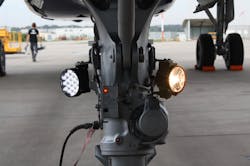Newer LED models are increasingly common as exterior aircraft lighting solutions for both commercial and business aircraft, so much so that they are also available for retrofit. In this first story on exterior aircraft lighting, we have reached out to industry experts to assess the extent LED lighting solutions have been embraced, and what to consider in the cost-benefit analysis for deciding when to upgrade older lamps to newer LED models.
Common lighting solutions
John Fogel, product manager at Amglo, says LED lights are becoming increasingly common for exterior lighting; indeed, many airlines and aircraft operators are retrofitting their older aircraft, and LEDs are also available for retrofitting.
“LED exterior lighting has become very common in commercial and business aviation and are available for retrofit from several suppliers,” affirms Heads Up Technologies, which specializes in end-to-end design, qualification, manufacturing, and field support of both interior and exterior LED lighting systems.
Almost all new production aircraft come equipped with exterior LED lighting systems, affirms Andre Hessling, principal fellow at Collins Aerospace – Interiors. “While there are still many legacy aircraft operating today with xenon, halogen or fluorescent bulbs, operators are seeing the many benefits to retrofitting existing technology with LED lighting systems,” he points out. “In the majority of cases, LEDs provide the same or improved functionality, while requiring far less power draw and lasting as much as 100 times longer than legacy lighting solutions. Operators see an expedited return on their new installation, realizing that the frequency, cost, and time spent on ongoing maintenance and replacement is much less with LED technology.”
Areas of Impact
LED lighting units can be installed in-parallel with other scheduled maintenance activities to minimize aircraft downtime and optimize installation costs. When analyzing if an upgrade from older lamps to LEDs is the right decision, some main areas of impact must be considered. “In the first place, the lifecycle costs given that LEDs have longer lives than legacy lighting systems and can provide a reduced direct operating cost and higher aircraft availability after the upfront installation costs. Then, in terms of performance, the LED lights are more energy and thermally efficient than traditional exterior lights,” says Heads Up Technologies.
The quality of illumination provided by LED lighting systems can improve crew situation awareness by providing better visibility during safety critical phases of operation, such as taxi, takeoff and landing. “Focused beam patterns from LED wing inspection lights also give the crew better visibility of the wing leading edge during icing conditions. As a last point, it is relevant to consider the empty weight and ESG since LED lighting systems are typically lighter than the legacy lighting systems and reduced empty weight improves the efficiency and carbon footprint of the operation,” affirms Heads Up Technologies.
Cost-Benefit Analysis
The cost-benefit analysis for upgrading older lamps to newer LED models in aircraft involves evaluating the costs associated with the upgrade and comparing them to the potential benefits gained, observes Fogel. “For this analysis it is necessary to first identify the existing lamps, determine the types and number of lamps currently installed in the aircraft, including their specifications, such as wattage, lifespan and maintenance requirements,” he affirms. “Secondly, it is necessary to research and identify LED lamp models that are suitable replacements for the existing lamps. It is also important to assess the costs, including the purchase and installation costs of the LED lamps and quantify the benefits like the energy savings, longer lifespan, reduced maintenance requirements, improved lighting quality, and potential weight reduction due to the lighter LED lamps.”
The potential savings have to be calculated based on the identified benefits, according to Fogel. “For example, the energy savings should be estimated and the reduction in maintenance costs based on the longer lifespan of the LED lamps calculated,” he says. “Consequentially, the estimated savings should be compared with the costs associated with the upgrade, this comparison will help determine if the benefits outweigh the costs and if the upgrade is financially viable.”
It is also important to consider additional factors that may influence the decision, such as regulations or industry standards and, finally, make an informed decision that should consider the financial, operational, and regulatory aspects, as well as the long-term benefits that LED lamps can provide, affirms Fogel. “It is important to note that the specific cost-benefit analysis may vary depending on the aircraft, the type of lamps being replaced, and other individual factors. Additionally, it is key to consider the potential risks and challenges associated with the upgrade. These may include compatibility issues with the aircraft’s electrical system, the need for additional modifications or certifications, and potential disruptions to operations during the installation process,” he says. “Furthermore, it is advisable to consult with experts or industry professionals who specialize in aircraft lighting systems to ensure accurate assessments of costs and benefits. They can provide valuable insights and guidance throughout the analysis process. Lastly, conducting regular reviews and updates of the cost-benefit analysis is recommended, as technology and market conditions may change over time. This will ensure that the decision to upgrade or not remains current and aligned with the aircraft’s needs and financial goals.”
When to Upgrade
According to Hessling, there are certain circumstances and environments where it makes more sense to keep using halogen lights, for instance in extremely hot environments where temperatures often times far exceed 120 degrees Fahrenheit. “From a total cost of ownership perspective, upgrading should always make sense when the aircraft is kept for more than two years. Conventional lights would always need maintenance within such a time frame (often multiple times), where LED lights would not,” he says. “It is not so much a cost-benefit assessment that limits upgrade, but lack of suitable technical options. From our technical understanding, a simple replacement of bulb to LED will become a very disappointing pursuit. LED units require different design philosophies to achieve the expect lifetimes of years and decades. Especially cooling, moisture and UV protection play a role. Only units from major suppliers with approvals or recommendations from original equipment manufacturers (OEMs) will likely provide the expected benefits.”
When determining whether it makes sense to upgrade older lamps to newer LED models in aircraft, several factors should be considered, according to Fogel. “One important point is the energy savings, indeed, if the aircraft operates frequently and for long durations, the energy savings from LED lamps can be significant, resulting in lower fuel consumption and operational costs,” he points out. “Another factor includes the maintenance costs given that LED lamps generally have a longer lifespan and require less maintenance compared to older lamps.”
Fogel observes that LED lamps offer improved lighting quality, including better color rendering, brightness control and reduced glare so, if the existing lamps are outdated and do not meet the desired lighting standards or requirements, upgrading to LED lamps can enhance the overall lighting experience for passengers and crews. “Furthermore, if there are upcoming regulations or industry standards mandating the use of LED lamps in aircraft lighting systems, it may be necessary to upgrade regardless of the cost-benefit analysis. Compliance with regulations is crucial for maintaining safety and meeting industry requirements,” he says.
To evaluate whether it makes sense to upgrade older lamps, it is important to calculate the long-term cost savings, while the upfront costs of upgrading to LED lamps may be high, the long-term cost savings from energy efficiency and reduced maintenance can outweigh the initial investment, according to Fogel. “Finally, LED lamps are more environmentally friendly compared to older lamps, as they consume less energy and have a lower carbon footprint, so upgrading to LED lamps aligns with sustainability initiatives and can contribute to reducing the aircraft’s environmental impact,” he says. “It is important to assess these factors in relation to the specific aircraft, the operational characteristics, and financial goals. Considering the lifespan of the aircraft and the expected payback period of the upgrade is crucial in making an informed decision.”
Summing Up
In this first of a two-part story on exterior aircraft lighting we have assessed that LED external lighting solutions have been embraced to a large extent in both commercial and business aircraft, and we have considered several aspect to account for in the cost benefit analysis for deciding when to upgrade older lamps to newer LED models. In the next part, we shall focus on how LED exterior lights are tested to assess if they are degrading and the repair process for when they are not working.
About the Author

Mario Pierobon
Dr. Mario Pierobon provides solutions in the areas of documentation, training and consulting to organizations operating in safety-sensitive industries. He has conducted a doctoral research project investigating aircraft ground handling safety. He may be reached at [email protected].
